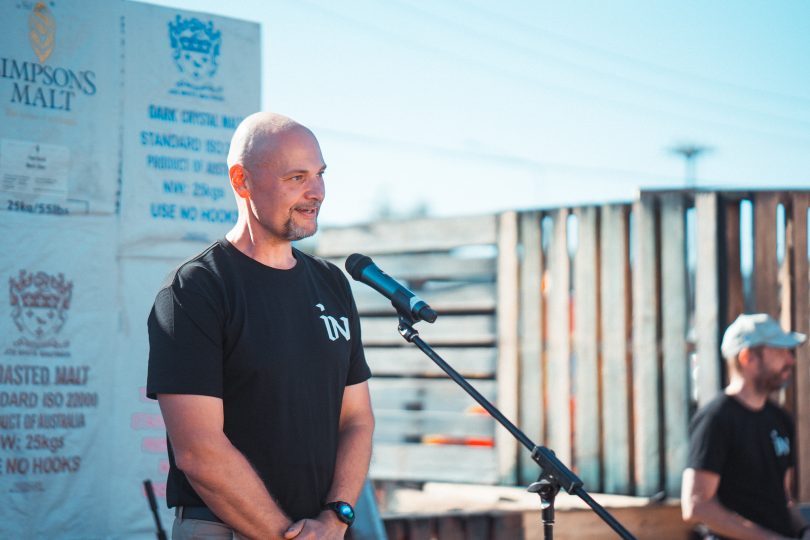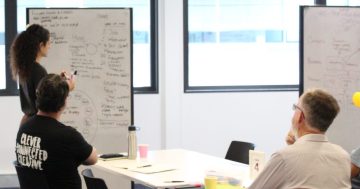
Canberra Innovation Network CEO Petr Adamek explores the concept of collaborative innovation. Photo: Canberra Innovation Network.
Innovation is more than a buzzword that covers a broad spectrum of new stuff, from inventions to changes in the way we do things. It’s not only an activity, initiative or capability – for organisations, it is a state of mind, a culture and a way of being.
Innovation potential is fluid, unstable, dispersed and dynamic. It exists in multiple forms and states outside of organisations, in networks, environments and ecosystems. What organisations have locked inside is only a fraction of their actual innovation potential, and that’s why collaboration and collaborative networks are so critical to organisational success in innovation.
‘Collaborative innovation’ seems to be the key emerging method of harnessing this innovation potential.
The not-so-good news is that collaboration – especially collaboration with the purpose to innovate – is very, very hard.
It’s not natural to us, and in many ways, it works against the general understanding of the traditional principles of ‘maximising value’.
To be able to collaborate effectively, we need to be prepared to share, listen and be influenced. We need to be exposed to different value frameworks and learn to understand value as defined by others. As a result of the collaborative innovation process, we (our organisation) will be changed. This is uncomfortable, unknown and too complex to control.
The Canberra Innovation Network team and partners have experimented over the years with new ways of bringing collaborative innovation into practice. We co-design and launch new programs that address gaps in our ever-growing and dynamic innovation ecosystem. For most of these, success is unknown. They may be imperfectly prepared, and they depend on many actors and their often conflicting motives and drivers to succeed.
It’s inevitable some of the initiatives we support will fail, but as an ecosystem, through these experiments we learn how to initiate and maintain the course in collaborative innovation.

Canberra Innovation Network CEO Petr Adamek talking to a group. Photo: Canberra Innovation Network.
So how do we successfully harness collaborative innovation? We believe it is by adopting the six characteristics of being genuine, tolerant, generous, obsessed, brave and fast.
- A genuine approach to collaborative innovation will be built on the collaborators’ core values. Those have to be close enough for all involved not to cause a collapse on the journey.
- A tolerant approach to innovation allows for imperfection, learning and different communication and execution styles.
- Generosity underpins success in collaborative innovation. You commit to share without any calculated benefits beforehand and let the collaboration evolve into benefits in the future that are unknown today.
- Be obsessed with progress, learning, shared benefits and impact. Not about control or being too rigid about how things are done.
- Be brave to cope with the difficult reality of underperforming metrics and failure, and to make decisions that are risky. Be brave to promote failures to encourage learning, and to understand that true innovation often feels really ‘harsh’.
- Last, but not least, if you aren’t fast, you are not going to be effective and you will miss opportunities. Short time-to-results cements collaborative relationships.

The Canberra Innovation Network has a series of solutions that enable participants to explore and embody collaborative innovation. Photo: Canberra Innovation Network.
To effectively kickstart collaborative innovation initiatives, Canberra Innovation Network has a series of solutions that enable participants to explore and embody all of the above principles.
Collaborative innovation labs and sandpits
Think multiple stakeholders, users, and even competitors, rivals, regulators and people from related industries and areas of expertise.
Think difficult open-ended questions, time pressure, teamwork, pitching of ideas, reflection, voting and selection on what to work on further.
Think ‘unconference’ and design sprint with diverse teams meshed together.
These are ‘collab’ labs. They have multiple forms depending on the issue, its owners and the character of the ecosystem in which the issue or opportunity exists, so are tailormade.
Hackathons
Those who prefer to assemble their own teams to work on problems tend to sign up for hackathons. These are intensive focused sessions often lasting 24 or 48 hours where things get done, not just ideated.
Prototypes, calculations and real projects often emerge. Mentors assist teams, and judges review relevance of the concepts and prototypes. Prize money is often involved.
Innovation challenges
If you know what you specifically want to solve and have funds, you may want to run an innovation challenge. These are competitions of approaches with teams ready to implement if selected and deliver pilots.
There’s no one right way to engage in collaborative innovation. There’s only a better way than last time.
So if you really want to just stop thinking and talking about it, do it. And then do it again.





















